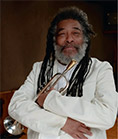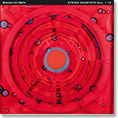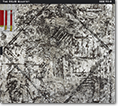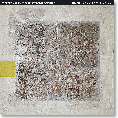THE MUSIC
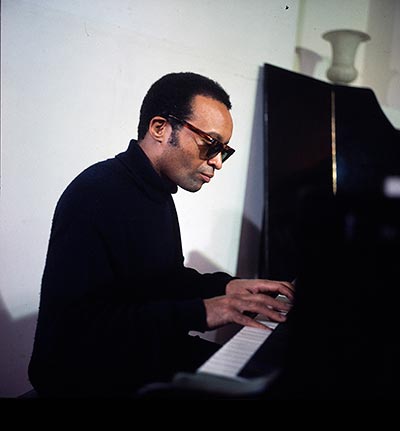
2 BLUES FOR CECIL
Among the many things that I learned with Cecil, the most important was the way he opened other doors for me to dance through with the unique melodies, rhythms and harmonies that he created and played within the Unit.
That being said, he respected and accepted what I brought to the musical table. Once he said to me "this music is our music!"
Therefore, playing with him was a give and take existential experience which lasted for many years — 11+.
Thank you, Cecil 🎹 !
Montclair, New Jersey, August 20, 2021
Andrew Cyrille
...
Cecil Taylor was a human being who would not allow his spirit to be broken by an oppressive racist society. He did not cow down to the jazz system. Cecil was a spokesman for individuality, a musical warrior always operating on a high level. He was not avant-garde, he was a human being who loves life as music. He would not be boxed in by the music world´s value system that asks artists to conform to their standards. Cecil emptied himself and was able to tap into the magical forces of nature. That´s it. In order to truly understand Cecil´s music, you have to see in Life its deeper reality not Life or music as a theory.
New York City, August 16, 2021
William Parker
...
Cecil Taylor. C.T. for the initiated. C for close friends.
One meter and 65 cm of interior strength, determination, genius and charm.
A Born Guru! You love him or you hate him. For sure, it is impossible to ignore him.
I can very well imagine Cecil just born, with his glasses and moustache, already surrounded and protected by a small group of loyal followers.
A Born Star!
Enrico Rava
Milan, August 16, 2021
...
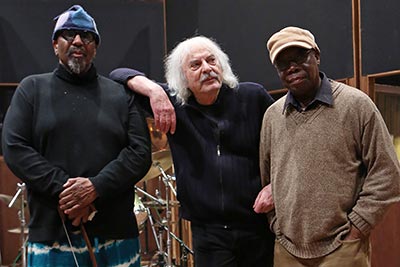
ANDREW CYRILLE, WILLIAM PARTER AND ENRICO RAVA
This record references pianist Cecil Taylor in several ways. There is no piano here, and no attempt to reanimate or imitate Cecil Taylor´s style of playing. This particular trio debuted at the April 2016 Open Plan exhibit on Cecil Taylor at the Whitney Museum in New York. It was still a relatively new prospect when brought together to perform in France in early 2020. They recorded on the following days—just before the world shut down.
Andrew Cyrille and William Parker had deep histories with Taylor, almost exactly the same profile, in fact, for non-overlapping stages of CT´s career. Cyrille and Parker are respectively the rhythm players who spent the longest "continuous" spell of time in the Units and related groups. They were the firmament while other band members came and went. Andrew was the drummer of choice for the Unit for close to 12 years starting in 1964. William was the regular bassist for Taylor groups (including the last Unit and beyond) for the baker´s dozen of years beginning in 1980. Their role in his music is simple to express, though profound in its impact. Both musicians´ voluminous discographies with and without Taylor fuel a study that we will carry on as long as listeners make their way to this music: Were Parker and Cyrille themselves formed by the ensemble or did they form it? They shaped the Unit shaped the music shaped them.
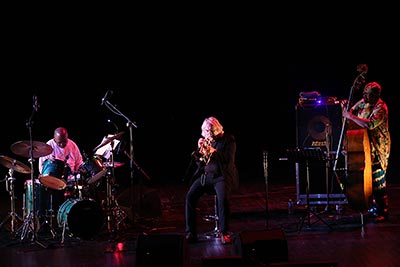
Enrico Rava was an occasional visitor to this spectrum—no more associated with Taylor´s oeuvre than he was with those of Steve Lacy, Bill Dixon, Roswell Rudd and others. He has been the globetrotting linchpin figure for Italy-meets-the-world / hosts-the-world scenario that has unfolded since the Sixties. The 1984 Orchestra Of Two Continents, with both Rava and Parker on board, gave early proof that Taylor´s approach could be effectively applied to a set of players who hadn´t been indoctrinated inside the Cecil Taylor system, but had grown up in the greater field of music that his concepts had fertilized.
Mostly, 2 Blues For Cecil honors Cecil Taylor by demonstrating some of the sterling music-making that continues to be done in the post-Taylor diaspora. In contrast to what Taylor wrought, this is how the rest of us do music the rest of the time. It benefits from the establishment of a free space in music (CT did that) and exercises that benefit to float, to stream and course onward. And to be oneself, unchained from the need to meet the predetermined structural demands. (CT manifested musically what the poets Robert Creeley and Charles Olson verbalized in their letters, that form is really just an extension of content.) Above all, be the self that you are, not the self that you´re asked to be.
** *
The greater catalog of Taylor´s wisdom suggests further principles to guide our listening.
Simple but surprising in The Cecil Taylor Universe is the sense that one´s current musical projection branches from a greater historical tree. As Cecil set it up, the solution is to be "Informed by the tradition without becoming prisoner to it." Taylor´s moon, as he religiously pointed out, reflected light from his forebears: Ellington, Waller, Monk, Powell and others. Whether through the ancestors or other undefinable external sources, William Parker has been clear that The music comes through me. Its ultimate, ur-source is a place beyond these vessels.
"I always felt like I had a responsibility to the drummers who came before me in Jazz." Thus spoke Andrew Cyrille (recently declared the "Kenny Clarke of modern jazz," in a 2021 convening of the Crossing Tones Power Hour). "I use what I learned from them. We all thought about Max Roach, Kenny Clarke… Everything was in there. It´s always been there." Cyrille touches the ground in homage to the patterns and materials of Jazz drumming, but in his wise musical projections, he needs not play idle figures as placeholders. His lines lie irregularly, dynamically, across the flow of pulse. Swing on the drums and sing on the drums.
Taylor has now joined that pantheon of ancestors. On this record, William and Andrew do what they did in Cecil Taylor´s world, which is also what they´ve contributed to the greater field of Jazz for 50 and 60 years, respectively. If it were a product newly launching in the market, their output might be branded Intelligent Propulsion or some such; it trades uniform locomotion for the ability to expand, breathe, recalibrate to the needs of each moment. That sort of shifting momentum is very much a Taylor precept.
* * *
This trio investigates fragility, a level of the mystery scarce in Taylor´s music. The fragility of line against the inexorable forward motion. And then the real vulnerability of melting the "rhythm section" convention into oblivion, as on "Top, Bottom and What´s in the Middle" where rhythm players are equal partners. Without drums the very exposed "Improvisation No. 2" brings us to a glassy lake that´s still, except where stirred by the creatures that live in it.
In this environment of delicate musical thought, we witness another CT principle at work: "Sing." Cyrille would have heard Maestro Taylor exhort students this way. However natural it feels to apply that instruction to wind instruments in the front line—like Rava´s lyrical flugelhorn here or Jimmy Lyons´s alto saxophone in the Unit—every performer has this mandate to "sing." Play it like you mean it. Also, mean it. To sing on the instrument is to surpass the basic level of sound-production: Squeeze out an expression rather than calculating each note. Muscles collaborate, alloying individual twitches into gesture. The way we discuss music´s increments of pitch, dynamics, rhythm oversimplifies the matter. A line comes alive when singing fuses these dimensions—along with tone, texture and a dollop of je ne sais quoi—organically into an energy flow.
2 Blues For Cecil is all about the singing property of musicianship. We can easily appreciate Cyrille´s lines and William Parker´s as their own self-sufficient, buoyant narrative, rather than just pickets on somebody else´s fence. "Improvisation No. 1" shuffles to the top of the stack to best exhibit that propulsion. Its fluid spacing between gestures constitutes the highest prize of modern music. There is no cause for alarm as the trio steps into or out of Rava´s themes, or when they twice submerge into the most ancient paradigm on the "Blues for Cecil." Or even a standard like "My Funny Valentine" that was designed with words, to be literally sung. This singing quality transcends words, structure, genre, style. Singing consists in how you touch and shape each note as its own meaningful morsel. It involves being present and actual—the opposite of rhetoric, licks, or of "phoning it in." For as many times as Cecil Taylor played 9,400 individual notes in one concert set, each sound was unique, discreet, vital, charged with energy to sing on its own.
* * *
Try on the idea that Cecil Taylor´s lasting art-historical impact on the field is the moon of our sector of the music. An ongoing force. That may seem a strange depiction, considering the inorganically indigestible density present in Taylor´s art itself: By super-saturating the pace at which we can absorb, it´s as though he suspended rhetorical flow and the tidal cycle of breathing and rest—in his music. But in the figurative pantheon of inspiration, Taylor, like the moon, gives off a light that is sometimes robust enough to outline our path on its own, and sometimes is a jewel to ogle in the distance. For the moon to drop out of sight means only that a mundane cloud covering has blocked our perception, or that it´s on a momentary rope-a-dope before it returns to straighten us out.
Even when we´re not looking at it or thinking about it, the moon is an entity so profound that its very being constantly tugs at the earth. The tides, that is: the ebb and flow of existence—Nature´s original traffic light, which enables or prevents. Beyond the illumination from Taylor´s moon, which we sometimes see and sometimes choose not to, he exerts this tidal gravitation, subtly and persistently shaping how we move through life.
Summer 2021
Ben Young
...
THE MUSIC
Improvisation No. 1 (Andrew Cyrille, William Parker and Enrico Rava) is a collective improvisation.
Ballerina (Enrico Rava) was written by Rava in 1991 for Quatre, a group he then had with pianist Franco D´Andrea, bassist Miroslav Vitous and drummer Daniel Humair. "Ballerina" was also included on the quartet´s second recording, Earthcake, in 1991. It was inspired by the pirouette of a classical dancer, a ballerina.
Blues for Cecil No. 1 (Andrew Cyrille, William Parker and Enrico Rava) is a collective improvisation.
Improvisation No.2 (Andrew Cyrille, William Parker and Enrico Rava) is a collective improvisation.
Top, Bottom and What´s in the Middle (Andrew Cyrille) was created by Cyrille for this recording. Andrew Cyrille: "As the music unfolds, I leave those timbral instrumental selections of trumpet, bass and drums to the listener."
Blues for Cecil No. 2 (Andrew Cyrille, William Parker and Enrico Rava) is a collective improvisation.
Enrava Melody (Andrew Cyrille)was written by Andrew Cyrille especially with Enrico Rava in mind.
Overboard (Enrico Rava)was composed by Enrico Rava for a duo he had with pianist Enrico Pieranunzi and was inspired by Ornette Coleman´s music. Rava and Pieranunzi first recorded it on Nausicaa in 1993 and Rava has revisited the composition since that time on Electric Five (1994), Tati (2004), Wild Dance (2015) and My Songbook (2016).
Machu Picchu (William Parker)as a composition is essentially a bass line in E. The horn line and drum response are improvised. Parker´s vision comes from the ancient Peruvian city built by the Incas. Each performance has a different flavor. Parker previously recorded "Machu Picchu" on his solo bass album Lifting The Sanctions in 1997.
My Funny Valentine (Richard Rodgers and Lorenz Hart) was originally written by Richard Rodgers and Lorenz Hart for the musical Babes In Arms in 1937. The song became a popular jazz standard and has appeared on close to 2,000 recordings if not more.

